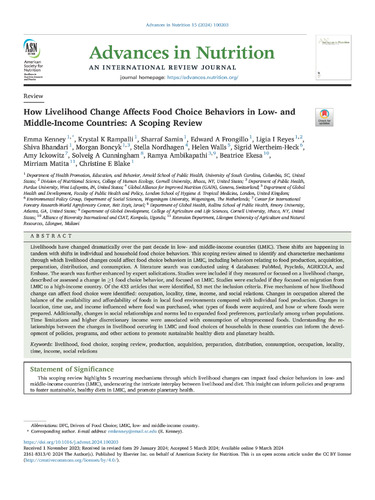How livelihood change affects food choice behaviors in low- and middle-income countries: A scoping review
Livelihoods have changed dramatically over the past decade in low- and middle-income countries (LMIC). These shifts are happening in tandem with shifts in individual and household food choice behaviors. This scoping review aimed to identify and characterize mechanisms through which livelihood changes could affect food choice behaviors in LMIC, including behaviors relating to food production, acquisition, preparation, distribution, and consumption. A literature search was conducted using 4 databases: PubMed, PsycInfo, AGRICOLA, and Embase. The search was further enhanced by expert solicitations. Studies were included if they measured or focused on a livelihood change, described or assessed a change in >1 food choice behavior, and focused on LMIC. Studies were excluded if they focused on migration from LMIC to a high-income country. Of the 433 articles that were identified, 53 met the inclusion criteria. Five mechanisms of how livelihood change can affect food choice were identified: occupation, locality, time, income, and social relations. Changes in occupation altered the balance of the availability and affordability of foods in local food environments compared with individual food production. Changes in location, time use, and income influenced where food was purchased, what types of foods were acquired, and how or where foods were prepared. Additionally, changes in social relationships and norms led to expanded food preferences, particularly among urban populations. Time limitations and higher discretionary income were associated with consumption of ultraprocessed foods. Understanding the relationships between the changes in livelihood occuring in LMIC and food choices of households in these countries can inform the development of policies, programs, and other actions to promote sustainable healthy diets and planetary health.

